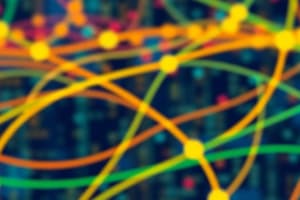Podcast
Questions and Answers
What percentage of the total course evaluation is attributed to attendance and review exercises?
What percentage of the total course evaluation is attributed to attendance and review exercises?
- 5%
- 15%
- 10% (correct)
- 20%
Which of the following is a primary textbook for the course?
Which of the following is a primary textbook for the course?
- Computer Networking Essentials
- Data Communications and Networking
- Fundamentals of Computer Networking
- Data and Computer Communications (correct)
When is the Midterm Exam scheduled?
When is the Midterm Exam scheduled?
- October 15, 2024
- September 30, 2024 (correct)
- November 2, 2024
- October 8, 2024
What is the overall percentage weight of the final exam in the course evaluation?
What is the overall percentage weight of the final exam in the course evaluation?
What topics will be covered in Week 3 of the class schedule?
What topics will be covered in Week 3 of the class schedule?
What will occur in Week 6 of the class schedule?
What will occur in Week 6 of the class schedule?
What is one of the key topics covered during the class relating to WAN technologies?
What is one of the key topics covered during the class relating to WAN technologies?
Which week is dedicated for a reading break prior to the Midterm Exam?
Which week is dedicated for a reading break prior to the Midterm Exam?
What is the consequence of cheating in this course?
What is the consequence of cheating in this course?
What is the focus of Chapter 1 according to the course outline?
What is the focus of Chapter 1 according to the course outline?
What is the main purpose of packet switching in communication networks?
What is the main purpose of packet switching in communication networks?
Which of the following is a characteristic of Frame Relay technology?
Which of the following is a characteristic of Frame Relay technology?
How does Asynchronous Transfer Mode (ATM) differ from Frame Relay?
How does Asynchronous Transfer Mode (ATM) differ from Frame Relay?
What is the main characteristic of Local Area Networks (LAN)?
What is the main characteristic of Local Area Networks (LAN)?
Which type of network serves as a middle ground between LAN and WAN?
Which type of network serves as a middle ground between LAN and WAN?
What was the origin of the Internet?
What was the origin of the Internet?
What is a key feature of packet switching as used in modern communication networks?
What is a key feature of packet switching as used in modern communication networks?
Which of these statements is true about the data rates of Local Area Networks compared to other network types?
Which of these statements is true about the data rates of Local Area Networks compared to other network types?
What is the primary function of a network in data communications?
What is the primary function of a network in data communications?
Which of the following are considered key performance criteria for networks?
Which of the following are considered key performance criteria for networks?
What type of network primarily spans large geographical areas?
What type of network primarily spans large geographical areas?
What technology utilizes a dedicated path for the duration of a conversation?
What technology utilizes a dedicated path for the duration of a conversation?
Which factor is NOT considered when evaluating network reliability?
Which factor is NOT considered when evaluating network reliability?
What term refers to the combination of voice, data, image, and video technologies in networking?
What term refers to the combination of voice, data, image, and video technologies in networking?
Which of the following is not a technology used in WAN?
Which of the following is not a technology used in WAN?
What is an essential aspect of network selection for businesses?
What is an essential aspect of network selection for businesses?
What is the primary purpose of data communications?
What is the primary purpose of data communications?
Which option is NOT one of the effective characteristics of data communication?
Which option is NOT one of the effective characteristics of data communication?
What does jitter refer to in the context of data communication?
What does jitter refer to in the context of data communication?
Which data flow method allows for two-way communication but not simultaneously?
Which data flow method allows for two-way communication but not simultaneously?
What trend is influencing the growth of data communications?
What trend is influencing the growth of data communications?
Which of the following describes a significant change in networking technology?
Which of the following describes a significant change in networking technology?
What is causing the unpredictable nature of corporate data traffic patterns?
What is causing the unpredictable nature of corporate data traffic patterns?
Which device has significantly impacted the rapid conversion of consumer electronics to digital technology?
Which device has significantly impacted the rapid conversion of consumer electronics to digital technology?
Which task is NOT typically considered a key communications task?
Which task is NOT typically considered a key communications task?
Which statement best describes 'everything over IP' as a trend?
Which statement best describes 'everything over IP' as a trend?
Which communication model component is involved in transforming data?
Which communication model component is involved in transforming data?
In which area have customized services become more prevalent in recent trends?
In which area have customized services become more prevalent in recent trends?
What is a significant factor behind the increased capacity of transmission in modern networks?
What is a significant factor behind the increased capacity of transmission in modern networks?
Which component is responsible for routing data in communications?
Which component is responsible for routing data in communications?
Flashcards are hidden until you start studying
Study Notes
Course Information
- Instructor: Asst. Prof. Dr. Sasiporn Usanavasin
- Course Code: CSS331 - Fundamentals of Data Communications
- Sections meet on Tuesdays and Wednesdays in Room 3509, 9:00 AM to 12:00 PM.
Course Structure
- Attendance and Review Exercises: 10% (random checks)
- Assignments (individual & group): 30% (includes 2 presentations)
- Midterm Exam: 30%
- Final Exam: 30%
- Cheating results in an automatic failure (F).
Required Textbooks
- Main Textbook: "Data and Computer Communications" by William Stallings
- Additional Reading: "Data Communications and Networking" by Behrouz A. Forouzan
Class Schedule Highlights
- Week 1: Introduction to Data Communications and Protocol Architectures
- Week 2: Data Transmission and Transmission Media
- Weeks 3-4: Signal Encoding Techniques; Error Detection and Correction Techniques
- Week 6: First Group Presentation
- Midterm Exam on September 30, 2024
- Fourth Group Presentation in Week 14
- Final Exam on December 2, 2024
Data Communications Overview
- Data communications involve the exchange of information between devices using transmission mediums like wire cables.
- Key attributes of effective data communication include:
- Delivery to intended recipients.
- Accuracy of transmitted data.
- Timeliness of communication.
- Jitter, or uneven delays in streaming data.
Components & Trends in Data Communications
- Main components include:
- Data flow (simplex, half-duplex, full-duplex)
- Addressing, routing, and signal generation
- Trends driving changes:
- Rapid traffic growth and technological advancements.
- Internet of Things (IoT) expanding service requirements.
- Growth of high-speed LANs and corporate WAN needs.
Networking Technologies
- Increased reliance on:
- High-speed LANs for centralized computing and server farms.
- WANs to accommodate growing telecommuting and data-intensive applications.
- Digital electronics and improvements in bandwidth efficiency.
Networking Models and Communication Tasks
- The communications model consists of processes for data generation, encoding, transmission, and decoding.
- Key tasks in communication include signal generation, message formatting, error detection/correction, and network management.
Transmission Media
- Selection criteria depend on business needs and link distances.
- Advances in technology favor fiber optic and wireless options.
- Cost efficiency remains a priority despite high transmission costs.
Networking Basics
- A network comprises interconnected devices (nodes) capable of data generation, sending, and receiving.
- Network evaluation criteria include performance (transit time, response time), reliability, and security.
Types of Networks
- Local Area Networks (LAN): smaller scope, owned by users, high data rates (e.g., Ethernet).
- Wide Area Networks (WAN): larger geographical spans relying on public circuits, employing technologies like circuit switching, packet switching, and asynchronous transfer mode (ATM).
- Metropolitan Area Networks (MAN): bridges the gap between LAN and WAN, offering high speeds across larger areas.
Switching Techniques
- Circuit switching: Establishes a dedicated communication path, e.g., traditional phone networks.
- Packet switching: Sends data in packets to be routed independently; efficient for computer-to-computer communication.
- Frame Relay: Enhances packet switching, reduces overhead errors, and increases speed.
- ATM: Evolves from Frame Relay, uses fixed-length packets (cells), supports higher speed data transfer with minimal error control overhead.
Studying That Suits You
Use AI to generate personalized quizzes and flashcards to suit your learning preferences.




